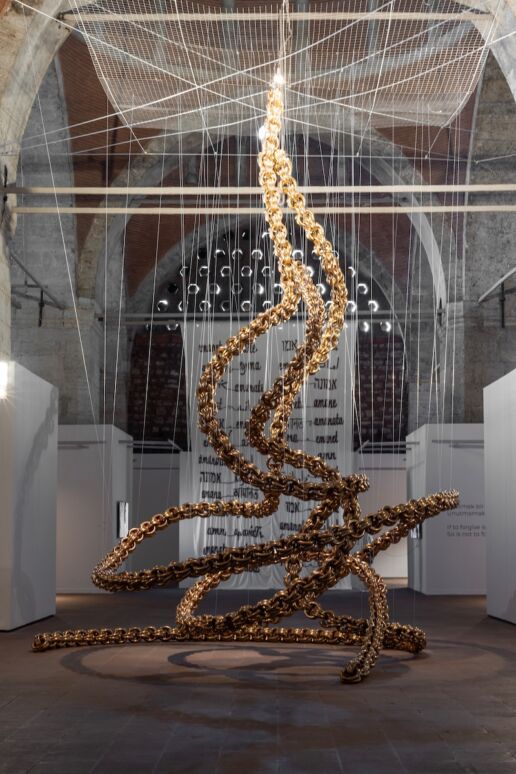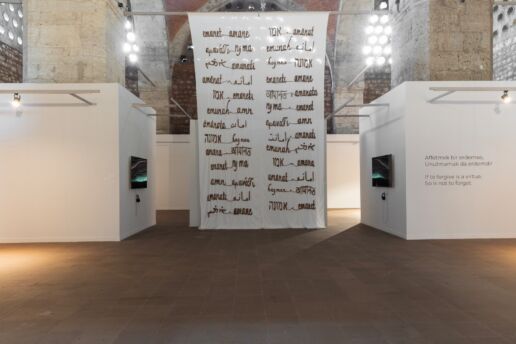HERITAGE UNDER FIVE DOMES: EMANET
Dedicated to an Anatolian folk tale, Vuslat’s solo exhibition, ‘Emanet,’ describes different manifestations of the concept of safekeeping. Curated by Ebru Yetişkin, the exhibition at MSGSÜ Tophane-i Amire Culture and Art Center is open from 22 May to 30 July.Photography: Nazlı Erdemirel
It was an extremely hot afternoon when I met with Vuslat in the Beş Kubbe (Five Domes) Hall of Tophane-i Amire. We talked about her solo exhibition, which she describes as a polyphonic recording of memory, and the concept of safekeeping, a topic she researched comprehensively for this purpose. The exhibition uses sculpture, painting, poetry, sound, and installations to convey the concept of safekeeping. Abstract sparrow drawings on canvas suspended from the high ceilings of the historical building and a huge chain sculpture stand out in the center. The works selected for the exhibition might be produced in different techniques using different media, but they display a strong connection, like they are part of a whole united under a single belief.
Paper: How was the exhibition conceived?
Vuslat: Both my parents are from Kelkit, Gümüşhane. I visited the region occasionally in the past but I never developed a physical bond with it until recently. On the other hand, the culture, traditions, customs, values, folk tales, and memories of the region have always been with me, handed down by my family for me to keep safe. I always had an inclination to find out more. Art plays a big role in my life, and I feel compelled to investigate my past to anchor myself. This feeling of growing roots and dropping anchor has been in me all the time. This was the main instinct that encouraged me to investigate the region where my parents came from. While reading the local tales, I came across the one about a sparrow. I remembered my grandmother because that was the only tale she ever told me. I spent days investigating the concept of safekeeping and what it meant in our culture. The exhibition seeks to answer the question, ‘What are the current rules of living together?’ The word emanet (safekeeping) is derived from the root ‘E-m-n’. I built an even deeper bond with the concept after discovering that the word semantically and phonetically exists in different languages.
P: What does safekeeping mean to you? Can you elaborate on its meaning and the impact it has had on your work?
VS: Safekeeping is taking good care of something entrusted to you or something that does not belong to you, as if it were your own. In fact, taking good care of something, even if it belongs to someone else, is one of the most profound virtues of being human. As Ebru Yetişkin said, ‘Safekeeping is the practice of taking responsibility without expecting anything in return.’ The works in this exhibition are based on this concept and encourage the viewer to protect what they are entrusted with.
P: You worked with the artist Pelda Aytaş from Diyarbakır on the piece called ‘Kucaklaşma / Embrace.’ Can you tell us about this collaboration and the production process?
VS: ‘Kucaklaşma/Embrace’ symbolizes the phonetic unity of the word emanet (safekeeping), which has a common meaning in nine different languages in this part of the world. This is the joint work of two artists with roots in Diyarbakır and Gümüşhane. It shows the different meanings, sounds, and alphabets used to speak and write the word emanet in Aramaic-Syriac, Hebrew, Arabic, Persian, Urdu, Turkish, Greek, Bosnian, and Kurdish. Kucaklaşma/Embrace’ is made from a special wool that is used in making the local zili rugs in community centers across Kelkit, Gümüşhane, to reflect the cultural diversity and polyphony of this region.
P: This exhibition originally opened in the Baksı Museum. What led you to open a second exhibition at the Tophane-i Amire Art Center in Istanbul? How does a venue contribute to the story the works convey to the audience?
VS: I spent ample time preparing for the exhibition at Baksı Museum – examining the geography, stone formations, soil, mines, flora, oral history, and folk tales of the Gümüşhane-Bayburt region. My interest in the concept of safekeeping started with my first exhibition, but there is still a lot of research to be done. The idea of bringing the exhibition to wider audiences in other places with a growing number of artworks was always there. The concept has left its mark in different ways in many places. This exhibition features new works that examine the theme of safekeeping in addition to the collection displayed at the Baksı Museum. It was a dream to have the exhibition in Tophane-i Amire. Needless to say, the historical characteristics of this venue remind most people of their heritage, and this was something I wanted very much. However, the process of the works themselves is more important than the venue. What matters is where they come from, where they go, and where they can take the audience.
P: The recorded memory ‘Sparrow’s Tale’ is accompanied by a light installation and a reading chair. What is this story about, and how did the idea materialize?
VS: My grandmother would tell me the tale of the Little Sparrow. It is about a mischievous little bird. I would feel amazed at the trouble it caused for the village folk. However, I studied the meaning of the tale and rewrote it, after which I became aware of the inherent concepts of trust and betrayal. As humans, we know that safekeeping something is an opportunity to honor ourselves and exalt our values, but it often goes forgotten in the rush of daily life. On one side, we struggle to remember, and on the other, we seem to forget all the time.










